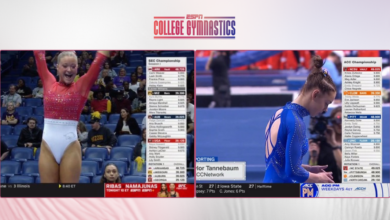Taking a whip-around the NCAA Women’s Tournament
You’re an avid NCAA women’s basketball fan. You’ve got your chips, dip and beverages of choice all set for the start of tomorrow’s 2012 NCAA Division I Women’s Basketball Championship. Now you just need to know when and were to tune in for ESPN’s exclusive coverage of all 63 games of the Tournament – across ESPN, ESPN2, ESPNU, ESPN3, WatchESPN and ESPN FULL COURT.
Before we get into some of the specifics, here’s a quick cheat sheet:
First Two Rounds (Saturday – Tuesday): ESPN2 will present 48 games within 12 telecast windows in a whip-around format with “home market protection” (see below for explanation). ESPN FULL COURT, the pay-per-view package, will offer complete games as a supplement to ESPN2’s coverage. In addition, ESPN3, via WatchESPN.com, will offer all games in their entirety. To view regional maps of the games that will be offered in specific parts of the country, visit the gallery above or here for details.
Remaining Games: The final 15 games, beginning with the Regional Semifinals on Saturday, March 24, will have national telecast windows on ESPN2.
(ESPN will also feature additional NCAA Championship content across its platforms, including SportsCenter, espnW, ESPN.com, ESPNEWS, WatchESPN and ESPN International.)
Front Row caught up with Carol Stiff, ESPN vice president of programming and acquisitions, to talk about ESPN’s women’s tournament coverage:
FR: ESPN2 will present its telecasts in whip-around format with “home market protection” through the first two rounds. Can you explain what that means?
CS: We televise 48 games in four days. Through regionalization, we program four games at one time. “Home market protection” gives fans from the home areas of teams that are playing the ability to watch from start to finish, not taking those viewers anywhere else.
The beauty of the “whip-around” format is, while the home markets are very happy, outside the home market protection areas we are going to give those fans one of the best of the four games being played. So, in summary, the national audience will get the best action that is being played and the home markets will be able to see what their home team is doing.
In addition, on ESPN3 via WatchESPN.com, the viewer can be his/her own program planner and decide which game in that window to watch.
What are the benefits of the whip-around format?
The greatest benefit of the whip-around format is that at any given time we will have a compelling game to go to. Let’s say Princeton is playing UConn, a No. 1 vs. No. 16, you figure it could be a 40-point difference. UConn fans in the state of Connecticut will be very happy to see that result, but most people outside of the state will want to see a more competitive game, like the No. 8 vs. No. 9. With the whip-around we’re able to serve everyone. It is a great formula.
How does ESPN programming determine areas of the country that will receive whip-around coverage and those that fall into a market protected area?
Once we get the bracket on Selection Monday, we look at the match ups and designated times, and then decide how the home market will be divided. Usually the rule of thumb is, if it’s a state school, like Tennessee for example, the whole state will be given the game. If it’s a school like St. Johns, a smaller private institution, then we have the option of giving viewers throughout the state — in this case, New York — other options, and we can divide the state by zip code, by county or even by street.
In each broadcast window, how does ESPN programming select the primary game in areas receiving whip-around coverage?
We have learned over the years that No. 1 vs. No. 16 is not the game to give the full nation because most likely fans will change the channel when it’s a 40-point game. We look at what we deem as the most compelling action at the time. A No. 8 vs. No. 9 would be looked at seriously, and we also look at the ratings of that institution and its geographical location. A large SEC school, like Georgia, might out-rate a smaller school like a St. Bonaventure, but we also want an exciting game.
What factors are taken into consideration when the decision is made to switch away from the primary game?
We have all the games up on one screen and stagger the start times so the first game will (likely) finish sooner than the last game of the four. We often ask ourselves, do we put the No. 8 vs. No. 9 game last out of the tip times, or do we put them first? A lot of time goes into the staggering of tip times and what should be the order. We also make a point to switch to the games that have the most compelling action.
Any schedule or other changes viewers can expect to see during this year’s Tournament?
For the first and second rounds we moved up some of the windows so the viewers can see games earlier in the day. While we will be up against the men’s coverage, there will be less overlap. Also, I’m thrilled we will be able to offer the local game of interest in High Definition. It was an evolution that we needed to make and with new technology in place we were able to do it. It was sort of a blemish on our coverage that frustrated our fans with these beautiful High Definition sets who were watching in Standard Definition.







